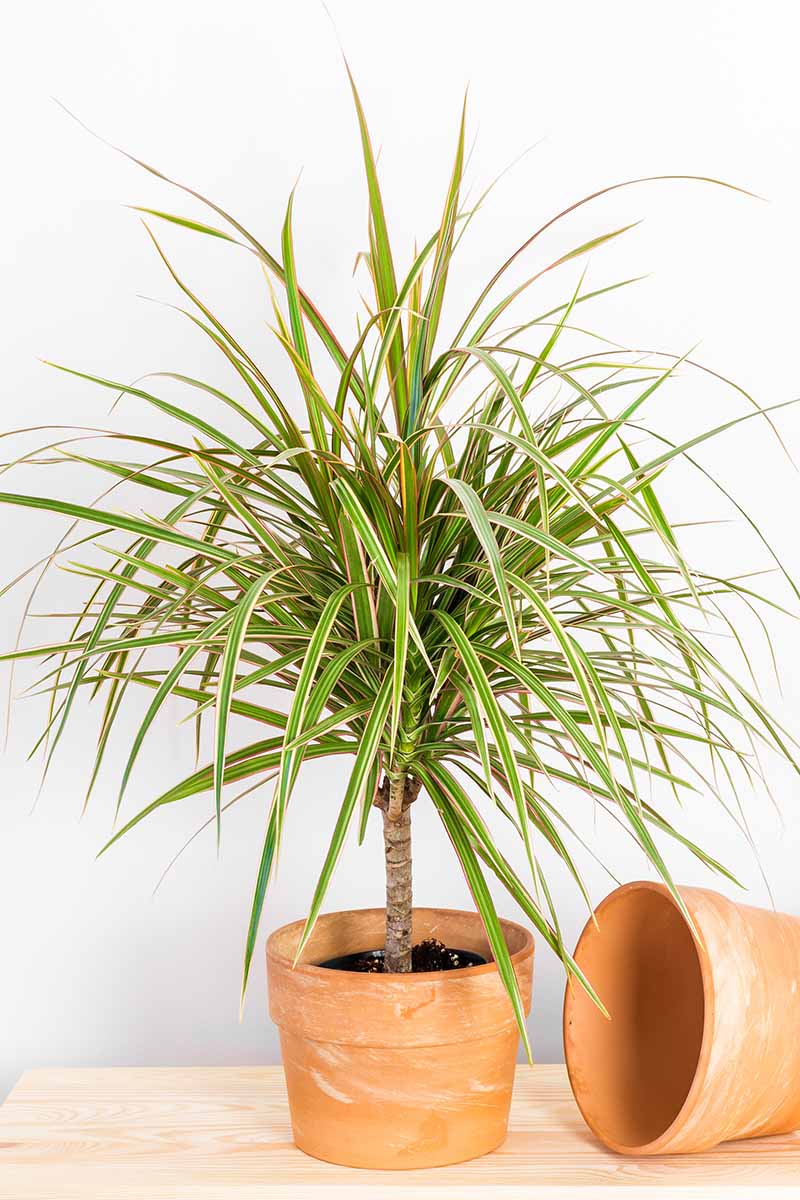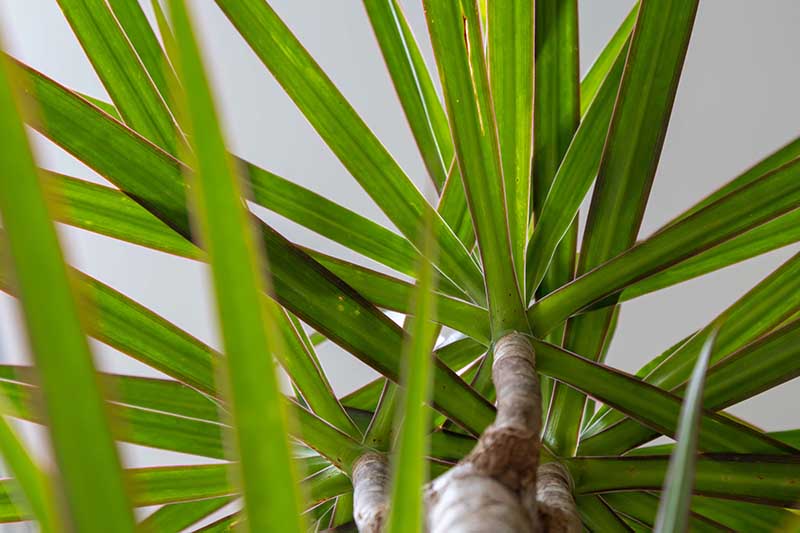Although you may fuss over and carefully tend your Dracaena plant, it could still come down with a disease.
This can happen precisely because of the care you have given it, in fact. Unlike many other types of lush houseplants, these plants prefer allowing the soil they’re planted in to dry out between waterings.
Watering that is too frequent can cause the roots to become vulnerable to diseases and rot, leading to symptoms including black stems.

We link to vendors to help you find relevant products. If you buy from one of our links, we may earn a commission.
Read on to learn how to prevent these diseases, and what to look for if your plant becomes infected.
Here’s everything we’ll cover:
What Is Causing My Dracaena’s Stems to Turn Black?
Several types of infections can cause black stems in Dracaena.
Fungal Root Rot
Your plant may first let you know that it is infected by wilting severely. While your inclination to solve this problem may be to give it a lot of water, this could make the situation even worse.

Paradoxically, wilting in Dracaena can be a sign of disease that’s actually due in part to an excessive amount of water.
At this point, rotted, black areas may become visible on the middle of the stems.
While you are not likely to want to cut open your poor plant, if you do, you will find that the tissues inside have a brown discoloration if fungal infection is the culprit.
Types of Fungi that Cause Black Stems
A number of species of fungi have been found around the world to cause stem rot on Dracaena. These include:
- Fusarium solani (Iran, Korea)
- F. oxysporum (Korea)
- F. moniliforme (Korea)
- Colletotrichum dracaenophilum (Bulgaria)
- Corynespora cassiicola (Egypt)
- Thielaviopsis paradoxa (Brazil)
Don’t worry about this long list. Just because a pathogen is active in Egypt does not necessarily mean that it will be a problem for you.
My intention here is to illustrate the prevalence of these types of symptoms in these plants when caused by fungal pathogens.
At home in the US, Fusarium solani is a common fungus, and it is the species that’s most likely to be a problem locally.
What to Do with an Infected Plant
In theory, you could remove the plant from its pot and trim back the rotted roots.
However, if your plant has already reached that point, and it’s already seriously infected, you will probably not be able to cure it.
As painful as it may be, your best bet is to dispose of the plant and sterilize the pot with a 10 percent bleach solution if you want to reuse it.
Tomato Spotted Wilt Virus
There is another dreaded pathogen that can afflict Dracaena plants, and it’s known as tomato spotted wilt virus (TSWV).
Don’t let the word “tomato” in its name fool you. This pathogen can attack over 1,000 species of plants.
It is ever-present in some areas, because it can infect many native species, weeds, and landscape plants.
TSWV has been known to cause hundreds of thousands of losses in a single greenhouse flower crop. And it can affect your houseplants too.
TSWV Spread
Without the little insects known as thrips, tomato spotted wilt virus would not be a problem.
Young thrips acquire the virus as they feed on diseased plants. When they become adults, the insects can transmit the infection.
The virus requires living plants to survive, and there is no shortage of potential hosts given the enormous host range of this virus.
Symptoms
Although symptoms start appearing seven to 20 days after the thrips acquire the virus, it is difficult to diagnose.
This is because so many other kinds of organisms and stresses to plants can mimic or closely resemble the symptoms of a tomato spotted virus wilt infection.
Black or purple streaks on the stems can be diagnostic for TSWV infections on Dracaena. The plants may be stunted, and leaves may drop prematurely.
Flowering plants may exhibit rings or stripes, lines, or colored spots on their petals.
Infected Plants Should be Purged
Regrettably, since this disease is so contagious and it may affect such a huge array of plants, you should dispose of your Dracaena if you think it is infected with this virus.
Black Stems on Dracaena are a Harbinger of Bad News
Several different kinds of pathogens can cause your plant to develop black stems, ranging from a who’s who of fungi to a widespread and pernicious virus.

Unfortunately, by the time your plant develops black stems, the condition is probably incurable.
You can prevent fungal infections by watering carefully, and waiting for the soil to dry out before you water.
Has your Dracaena developed a black stem? If so, let us know how it fared in the comments section below.
And for more information on growing Dracaena plants at home, have a look at these articles next:
My Dracaena tricolour has rot in the top of its stem. Mushy and leaves curling. What should I do?
I have not been overwatering it but I rescued it from a garden centre in the hope that I could save it. Is there anything that I can do to save it?
Hi Elizabeth! I’ve brought home many a rescue plant from home stores, so I totally understand what you’re going through. The best way to save your dracaena at this point is two-fold. First, take the plant out of the soil and brush away as much of the soil as you can. Spray the roots with a copper fungicide and repot in fresh soil. Now, cut the top of the plant off. Make the cut below where the stem looks healthy. Several times a day, you want to mist the cut top to encourage new shoots to form. You can also… Read more »
Help! I rescued a neglected 7ft corn plant from the lobby of my building which was too dark and too cold. It probably went from underwatered to overwatered for years. It was leggy, and the leaves got limp with brown spots. Branches started bending over from mushy dark spot in the middle. Each time, I cut those ends, trimmed back to firm stem, trimmed bad leaves, and put them in water, where they immediately perked up and started growing roots. Eventually I brought it into my apartment, let it adjust for a while, then repotted it. It looked like the… Read more »
Hi Jennifer, sounds like you’re doing all the right things to help that Dracaena marginata recover. Go ahead and cut those bent stems if you want to, they will regenerate. It’s a little easier on the plant if you let some of the bare trunks develop new leaves before you cut the others off, though.
My plant has gradually been getting worse losing all of her leaves and her stem turning brown, but I recently left town for a week and when I came back she looked like this. Is there anything to do to save her? 🙁
Oh dear, that plant looks miserable. At this point, the chances of saving it are pretty low. If you want to try, I would remove it from the container, remove all the soil, spray the roots with copper, and clean the pot with a 10% bleach solution. Repot it in fresh soil. Cut the stem back by about half and cross your fingers for new growth.
I have a dracaena Massangeana & it had slowly starting dying after getting it. I starting giving it filtered tap water instead, it came back, & was beginning to do really well as new nodes began to sprout out from all 3 cane stems. A week ago, however, I noticed that a newly sprouted node that was beginning to open up on one of the cane stems, was turning brown. A few days later, the base of a bunch of leaves higher up had also turned brown, lost its structural integrity, & had flopped over. And now, there’s another leaf… Read more »
It does sound like this plant has root rot. Follow the steps above to treat it, and consider removing the cane.
I bought these recently – one for me and one as a gift for Christmas. Is this root rot? Any suggestions?
Hi Cindy, it’s a little hard to tell from the photos, but it does look like some kind of stem rot rather than root rot. We talk about that above.
My lovely dragon plant has been with me for years now and has always had a bit of darkness at the bottom of the stem, but recently that discolouration seems to be moving upwards. I water it only when the soil is completely dry (via the little blue water globe in the picture) and it’s leaves are all very happy and buoyant – it’s recently had some new growth – but I’m worried about the discolouration and I can’t seem to find anything online about it. The entirety of the stem is dry to the touch and ever so slightly… Read more »
Hey there, this looks like your plant might have some root rot happening. If the “bark” feels loose, it could be a sign of rot in the center. To be safe, I’d remove the plant from the container and brush away all the soil. Examine the roots for anything soft or black and cut that away. Then, spray the roots with copper fungicide, clean the pot with soapy water, and repot with fresh potting soil. It sounds like you’re doing the right thing as far as watering goes, though the slow-release of the bulb could be holding moisture against the… Read more »
hi, i have two dragon tree plants that i’m kind of worried about. for one of them i have got rid of all the leaves as they turned brown and it started having new growth. it has two stems growing. the first stem is putting out new growth, however the second stem has turned brown and mushy.
for the second plant i have trimmed its leaves and repotted it because it was getting root bound. it’s also putting out new growth and but the stems near the soil have black spots.